
Latin Name
Morelia spilota cheynei.
Distribution
Morelia spilota cheynei has the smallest range of the Morelia spilota complex. Found in a limited area of Queensland, Australia around the coastal town of Cairns, their territory stretches north towards the Daintree river, south towards Ingham and inland from the coast towards the Atherton Tablelands.
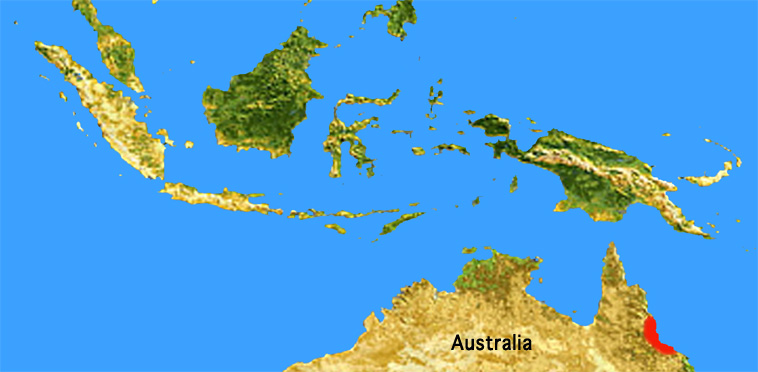
General Description
Captive Care
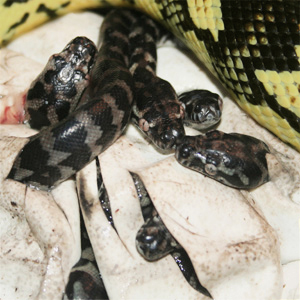
First look at the world.
These newly hatching jungle carpet pythons are emerging from their eggs after 56 days incubating in their mothers coils.
Body colour and patterning can vary considerably from a mixture of brown, tan and black markings on the lateral and dorsal areas based around general carpet python patterning to a velvet black and bright yellow banding on outstanding captive bred specimens. The ventral surface is light in colour and has varying amounts of dark speckling.
Jungle carpets go through an ontogenetic colour change as they mature. Starting as sometimes rather dull looking hatchlings their colour intensifies with each slough and becomes brighter. All hatchlings start out with varying amounts of dark tan, brown, gray and black markings that get lighter and brighter with each slough. The most outstanding black and yellow specimens can take 12 to 24 months to achieve their full colouration.
Much of the bright colouration that is seen in captive jungle carpet pythons is from years of selective breeding. The wild form of the jungle carpet although sometimes being vivid yellow and black is often more subdued in colour.
The images below show the same jungle carpet as it's colour progressed over time.
This individual had the most silvery gray colouration out of the clutch when it hatched and was the quickest to develop it's bright yellow and velvet black colouration whilst the rest of the clutch took a further six months to gain a similar amount of colour.
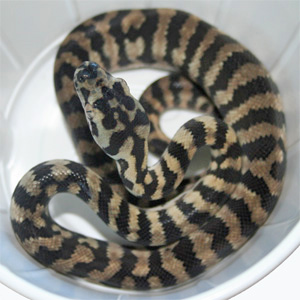
Two weeks old.
After 1 shed.
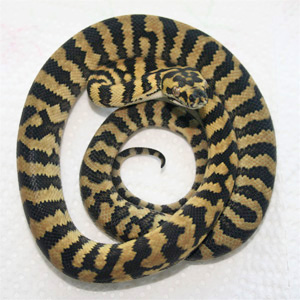
Two months old.
After 2 sheds
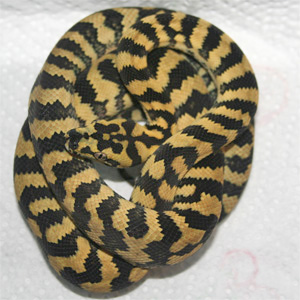
Three months old.
After 3 sheds.
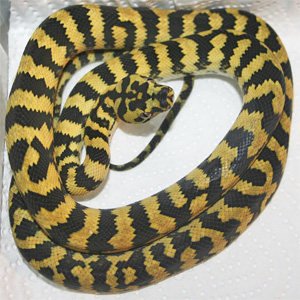
Six months old.
After
4 sheds.
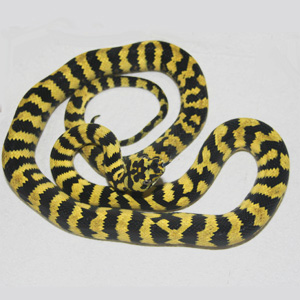
Nine months old.
After 5 sheds.
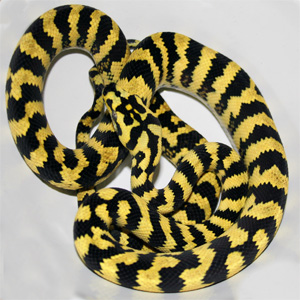
One year old.
After 6 sheds.
Like most python species jungle carpets have heat receptive pits, six on the upper jaw just below the nostrils and five or six on each side of the lower jaw. The eye is generally dark and has a pupil that narrows to a vertical slit during daylight hours.
Nocturnal in nature and semi arboreal the jungle carpet python like all Morelia species has a prehensile tail. They are ambush predators that catch their prey by laying in wait with a coiled "S" shape to the neck, for a meal to pass within striking range rather than actively hunting prey down.
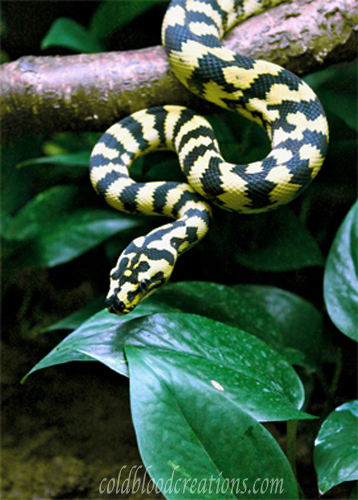
Typical "S" shaped ambush posture of a hunting Jungle carpet python.
Housing. There are various options as to how you can house your jungle python, such as plastic boxes, all glass terrariums, commercially made acrylic or plastic terrariums and home built wooden terrariums. All these examples have advantages and disadvantages compared with each other such as cost, how well they hold heat / humidity and how easy they are to keep clean. Provided the animal has a fair amount of space, somewhere to hide and feel secure and access to appropriate temperatures they can all be OK. Having said that I do believe that for quality of life and providing your animal with plenty of stimuli jungle carpets should be given enclosures that offer reasonable space to move around vertically as well as horizontal.
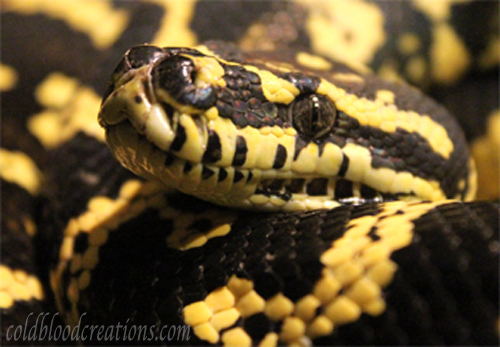
You can see the heat receptive pits in the upper and lower jaws.
The image also shows how intense the colour can become after 24 months.
This male was 48 months old when this image was taken.
Substrate in the enclosure can be as simple as newspaper / paper towels or more pleasing to look at, bark chipping's. The substrate needs to absorb waste matter and hold some moisture to help keep humidity up in the enclosure, especially when the snake is in a shed cycle .
Bark chip substrate will need to be spot cleaned and paper will need to be replaced when soiled.
I keep my snakes on a soil substrate that lets me control the humidity in my jungle carpets enclosures at a level that gives consistent good sheds. There is more information about the soil substrate I use in the terrarium section of this web site.
Hides can be made from old cardboard tubes, cardboard boxes, plastic tubs or for a more natural look, from cork bark. As long as the snake can have it's body in contact with the hide in a couple of places it should feel secure. You should also provide your jungle carpet with something to climb on as they can be quite arboreal snakes and will make use of any branches placed in the enclosure.
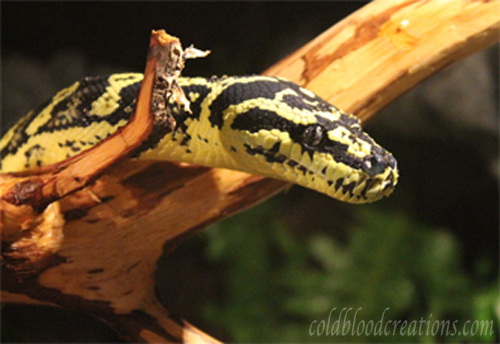
Temperature. Jungle carpets require a temperature gradient within the enclosure. This allows the snake to choose the temperature that it needs at various times.
Animals will often seek warmer (30 deg C) temperatures for several days when digesting a large meal and retreat to cooler temperatures (26 - 28 deg C) when not digesting food.
In general the enclosure should have a warm side and a cooler side. Heat can be provided by heat mats, heat panels, heat cable or ceramic heaters. Again there are advantages and disadvantages to each but whichever heating method you choose, it should be controlled by a reliable thermostat.
I provide my adult animals with a daytime air temperature of 28 deg C to 24 deg C using heat panels controlled by pulse proportional thermostats. I provide a basking area under the heat panel that reaches a temp of 31 deg. At night the ambient air temp drops to 26 deg.
My young carpets are provided with a constant temp gradient of 29.5 deg at the warm side of their enclosures to 27 deg on the cool side, with no night time drop.

Humidity. Jungle carpets are quite undemanding when it comes to humidity but a good range to aim for would be 40 - 60% relative humidity for routine maintenance.
I keep my Jungle's at ambient room humidity that is around 35% year round and I will raise it slightly with light spraying when an animal is going through a slough cycle. On the occasions that I have missed the slough cycle and not raised the humidity the snakes have still sloughed in one piece with no issues.
Lighting. Although nocturnal, jungle carpets will still benefit from some sort of light reaching their enclosure. It can be as simple as making sure the area in the house where they are kept receives some natural light from a window each day or by using artificial lights inside the enclosure.
I light my jungle carpet enclosures with LED lights and provide a 12 hour light cycle as this replicates their natural environment.
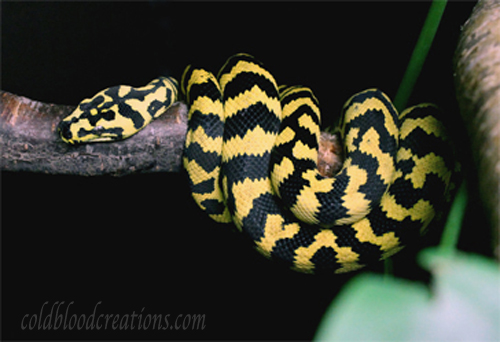
Here is another image of the jungle in the sequence of images above. In this image she is 19 months old.
Food. Baby jungle carpets will eat small defrosted fuzzy mice and can be fed every seven days. As they grow the size of the mice should be increased and at about a year of age feeding should be reduced to every seven to ten days. Adults and animals over two years of age can be fed and appropriate sized defrosted rat every fourteen days. These are just rough guidlines for feeding frequency and feeding less in my opinion is better than feeding more.
In the wild snakes are opportunistic feeders and food does not come along on a regular schedule. I follow the above feeding schedules loosely and prefer to watch what the snakes are doing. When they become more active after digesting a previous meal and seem to be actively looking for food I will wait a day or two before feeding them again. I don't believe it does the snakes any good to keep feeding them on a set schedule if they are not actively moving around their enclosures at night, as this could eventually lead to an obese snake.
This leads onto record keeping. It's a good idea to record dates when your snake is fed, when it sheds and to keep track of it's weight. Not only will this go some way towards avoiding the overfeeding of your snake, it can also help show any health issue that might arise before they become problematic.
Water.Water should be provided at all times and should be kept fresh. Plastic, glass or metal containers can be used and the water should be replaced a couple of times a week or when soiled. Bowls should be thoroughly cleaned and disinfected every couple of weeks or again when the water has been soiled.
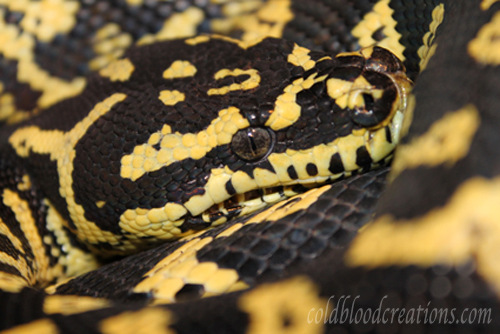
The above information is collected from various sources (click here for references) and from personal observations.
The captive care section is based on how I personally maintain this species. This is not the only way to successfully maintain this species and other keepers use different methods.
This is what works for me, with my animals and the size of collection that I work with.
